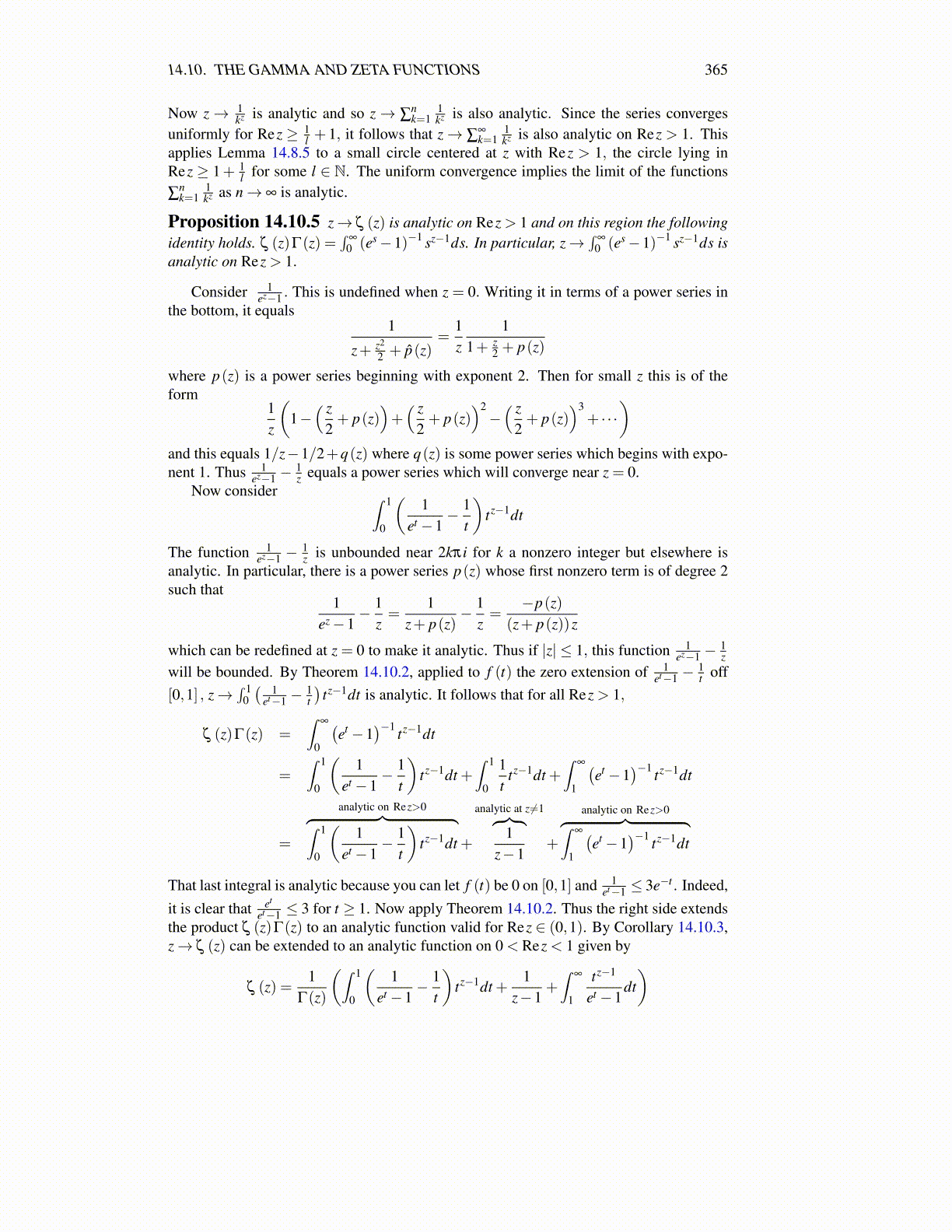
14.10. THE GAMMA AND ZETA FUNCTIONS 365
Now z→ 1kz is analytic and so z→ ∑
nk=1
1kz is also analytic. Since the series converges
uniformly for Rez ≥ 1l + 1, it follows that z→ ∑
∞k=1
1kz is also analytic on Rez > 1. This
applies Lemma 14.8.5 to a small circle centered at z with Rez > 1, the circle lying inRez ≥ 1+ 1
l for some l ∈ N. The uniform convergence implies the limit of the functions∑
nk=1
1kz as n→ ∞ is analytic.
Proposition 14.10.5 z→ ζ (z) is analytic on Rez > 1 and on this region the followingidentity holds. ζ (z)Γ(z) =
∫∞
0 (es−1)−1 sz−1ds. In particular, z→∫
∞
0 (es−1)−1 sz−1ds isanalytic on Rez > 1.
Consider 1ez−1 . This is undefined when z = 0. Writing it in terms of a power series in
the bottom, it equals1
z+ z2
2 + p̂(z)=
1z
11+ z
2 + p(z)
where p(z) is a power series beginning with exponent 2. Then for small z this is of theform
1z
(1−( z
2+ p(z)
)+( z
2+ p(z)
)2−( z
2+ p(z)
)3+ · · ·
)and this equals 1/z−1/2+q(z) where q(z) is some power series which begins with expo-nent 1. Thus 1
ez−1 −1z equals a power series which will converge near z = 0.
Now consider ∫ 1
0
(1
et −1− 1
t
)tz−1dt
The function 1ez−1 −
1z is unbounded near 2kπi for k a nonzero integer but elsewhere is
analytic. In particular, there is a power series p(z) whose first nonzero term is of degree 2such that
1ez−1
− 1z=
1z+ p(z)
− 1z=
−p(z)(z+ p(z))z
which can be redefined at z = 0 to make it analytic. Thus if |z| ≤ 1, this function 1ez−1 −
1z
will be bounded. By Theorem 14.10.2, applied to f (t) the zero extension of 1et−1 −
1t off
[0,1] , z→∫ 1
0( 1
et−1 −1t
)tz−1dt is analytic. It follows that for all Rez > 1,
ζ (z)Γ(z) =∫
∞
0
(et −1
)−1 tz−1dt
=∫ 1
0
(1
et −1− 1
t
)tz−1dt +
∫ 1
0
1t
tz−1dt +∫
∞
1
(et −1
)−1 tz−1dt
=
analytic on Rez>0︷ ︸︸ ︷∫ 1
0
(1
et −1− 1
t
)tz−1dt +
analytic at z ̸=1︷ ︸︸ ︷1
z−1+
analytic on Rez>0︷ ︸︸ ︷∫∞
1
(et −1
)−1 tz−1dt
That last integral is analytic because you can let f (t) be 0 on [0,1] and 1et−1 ≤ 3e−t . Indeed,
it is clear that et
et−1 ≤ 3 for t ≥ 1. Now apply Theorem 14.10.2. Thus the right side extendsthe product ζ (z)Γ(z) to an analytic function valid for Rez ∈ (0,1). By Corollary 14.10.3,z→ ζ (z) can be extended to an analytic function on 0 < Rez < 1 given by
ζ (z) =1
Γ(z)
(∫ 1
0
(1
et −1− 1
t
)tz−1dt +
1z−1
+∫
∞
1
tz−1
et −1dt)